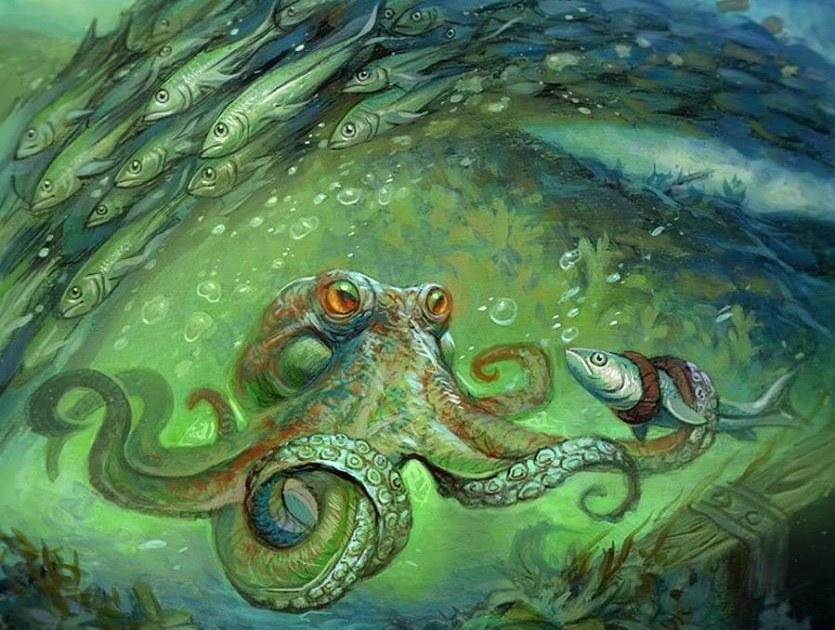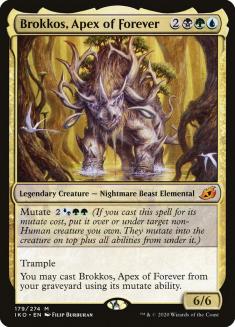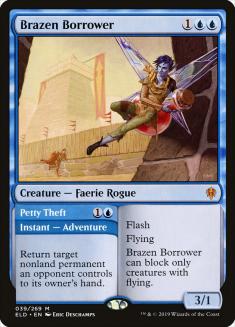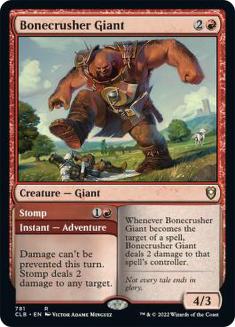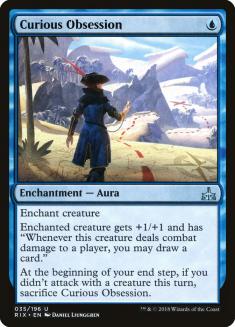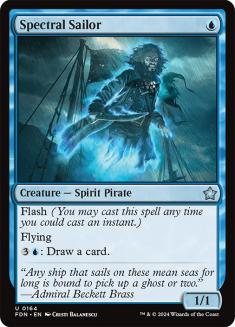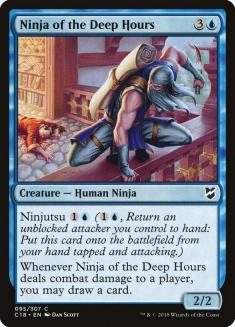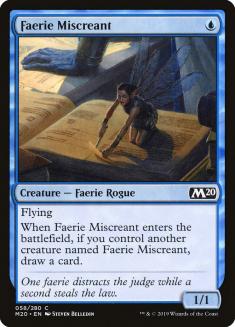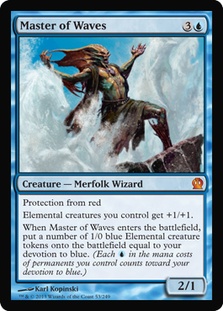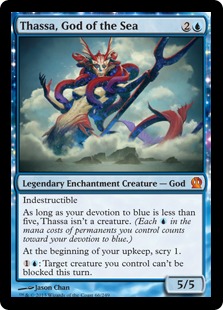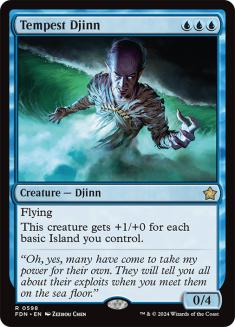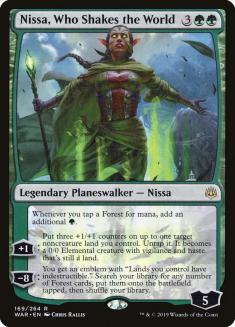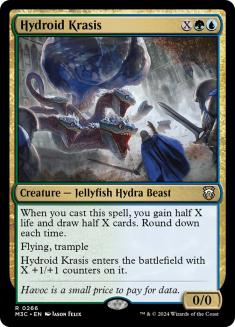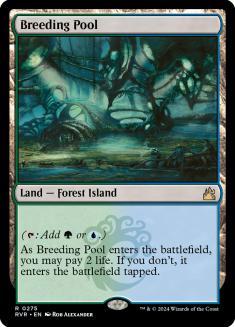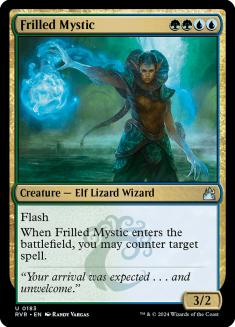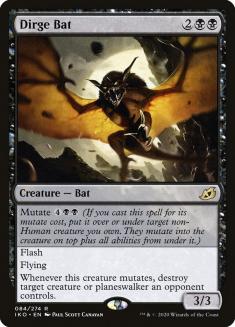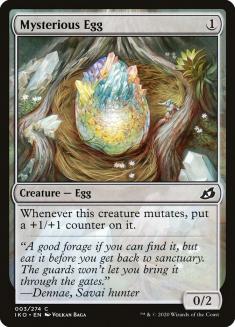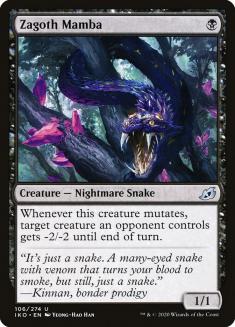Modal spells, modal spells everywhere.
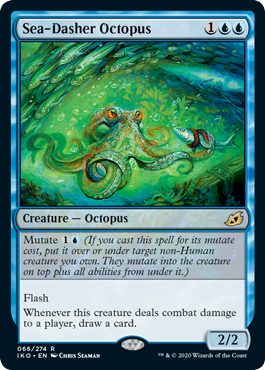
At first glance, Sea-Dasher Octopus reads as a Runeclaw Bear with Curiosity upside. It’s so much more. Sea-Dasher Octopus is one of the first mutate creatures that falls closer to being an Adventure creature than a creature with bestow. Most of that perception has to do with the mana cost of the ability.
When mutate was first revealed at the beginning of Ikoria: Lair of Behemoths preview season, most of the cards that were shown with that debut were big, splashy mythics and overcosted commons. This gave an overall impression that these cards were going to be expensive to mutate and many of the creatures would be used for their creature portion. A handful of creatures, like Sea-Dasher Octopus, have demonstrated other flavors of the mechanic.
The separate halves of the best Adventure cards would be unplayable on their own. Disperse doesn’t really see Constructed play and that goes double when it can only target the opponent’s permanents. Nimble Obstructionist is the closest thing there’s been to a vanilla 3/1 flash, flying creature, due to the card not having a body if it it was used for anything else, and that card didn’t see much play either.
Now compare Sea-Dasher Octopus? Ophidian Eye at two mana isn’t that much better than Staggering Insight, and a lack of flash wasn’t keeping Stealer of Secrets from seeing play.
Why Is Sea-Dasher Octopus Good?
Simply put: Sea-Dasher Octopus has the ability to snowball a game and its versatility gives multiple options for how to make that happen. The most natural homes for this kind of effect are tempo-oriented strategies:
Creatures (18)
Lands (12)
Spells (30)

Previously, Izzet Flash leaned harder on Gadwick, the Wizened to be able to keep up with other decks in raw cards. This was because all the cards in the deck being cheaper and efficient comes at a real cost: they’re weaker, and lack the same value as other engines in the format. Sea-Dasher Octopus offsets this in an incredible way.
For anyone who played much Ravnica Allegiance Standard, this is old hat, but simply having a way to draw two cards a turn while applying pressure is easy mode for this style of deck. With Gadwick, there’s a turn where the Izzet player is forced to commit five or more mana into building a card worth playing, and is frequently tapped out after casting it.
With the cards in Izzet being fairly anemic on their face, this play pattern leans a bit on being able to find a copy of something like Brazen Borrower, or else utilizing Gadwick’s tap ability, in order to keep up on the battlefield.
The Octopus only requires a single two-mana investment, and being a flash threat means that it can be slipped in on the opponent’s end step after they can cast anything too scary on their turn.
Sea-Dasher Octopus also creates incentives to revisit cards that were on the cusp of playability before, but were flying right under the radar. Having a curve of Turn 1 Spectral Sailor, Turn 2 “attack, mutate Octopus on top of Spectral Sailor to build a 2/2 with all of the abilities of the two creatures and draw a card” is a strong way to start a game.
Something that Sea-Dasher Octopus has on previous iterations of Curiosity is simply that it is a Stealer of Secrets // Ophidian Eye split card. This isn’t the first time we’ve had a card like this:
Ninja of the Deep Hours still sees play in Pauper. It has an exciting history in its Standard format, and a bit of Modern experience to boot:
Creatures (19)
- 4 Ninja of the Deep Hours
- 3 Spellstutter Sprite
- 4 Snapcaster Mage
- 4 Delver of Secrets
- 4 Faerie Miscreant
Lands (20)
Spells (21)

It isn’t hard to see why this card is markedly better than Ninja of the Deep Hours. Sea-Dasher Octopus is a more playable card in a vacuum, and is less restrictive to deploy with its ability. The shell that wants the Octopus can’t play Delver of Secrets (Humans can’t mutate), but it isn’t too difficult to imagine an aggro-control deck that wants to use this card to snowball an insurmountable advantage.
Creatures (20)
- 2 Ninja of the Deep Hours
- 2 Spellstutter Sprite
- 3 Snapcaster Mage
- 4 Faerie Miscreant
- 3 Spectral Sailor
- 3 Sprite Dragon
- 3 Sea-Dasher Octopus
Lands (19)
Spells (21)

In this list, I’ve worked to shave on copies of Humans in the deck for the aforementioned inability to mutate, but some of the cards just play too well to want to give up. There may be a bit too much going on here, but the theory itself is sound. When playtesting with new cards, a great approach is trying out a few things at once in order to get a feel for what packages are good enough and which ones aren’t going to cut it.
The key with this type of deck is making sure there are enough cheap enablers to make the Octopuses and Ninjas worth playing. In a format as streamlined as Modern, paying three or four mana for either of those cards is closer to a silver-lined fail state than an intended mode of the card.
Ideally, neither of these decks will doing much in the way of tapping out after the second turn, and having evasive one-drops is one of the best ways to ensure that can happen.
Sprite Dragon sticks out as a way to enable some busted Octopus-fueled draws. This is because Sprite Dragon normally wants its controller to continue committing spells for the sake of growing it. Sea-Dasher Octopus accruing the number of resources that it does actually puts the onus of action back on the opponent and creates play patterns that grow Sprite Dragon by virtue of its owner playing a sort of protect-the-queen strategy.
Izzet isn’t the only way to play a blue-based tempo game, however:
Creatures (26)
Spells (34)

Rather than trying to answer all of the important cards that the opponent presents, this is a more synergistic take on how to play with Sea-Dasher Octopus and by extension Curious Obsession. Between Spell Pierce, Mausoleum Wanderer, and Wizard’s Retort, there aren’t really that many answers. This deck is operating under the impression that it can get its wins in the mid-game by going over the top with things like Master of Waves, Thassa, God of the Sea, and Tempest Djinn.
On their faces, these cards don’t look like the absolutely most powerful cards to play as curve-topping threats, but the Curiosity effects in the deck create a dynamic that gives a ton of cards to play with. This creates incentive structures during the deckbuilding process to optimize the mana costs of cards for the sake of being able to actually make use of all the additional resources that are being created. In other words, if the deck had a ton of five-drops, for example, drawing so many cards a turn wouldn’t matter, because you’d still only be able to deploy one card a turn.
That doesn’t mean it’s impossible to play Sea-Dasher Octopus with big spells, however:
Creatures (17)
- 2 Hydroid Krasis
- 3 Frilled Mystic
- 4 Nightpack Ambusher
- 3 Brazen Borrower
- 2 Uro, Titan of Nature's Wrath
- 3 Sea-Dasher Octopus
Planeswalkers (4)
Lands (14)
Spells (25)

This iteration of Simic Flash is a bit more reminiscent of the pre-Uro, Titan of Nature’s Wrath iterations of the deck, yet has a lot going for it.
The most noteworthy thing in this deck is how Brazen Borrower really ties the room together. Borrower works with Octopus in both directions as mutate-fodder and as a way to get creatures out of the way of a Nine-Tailed White Fox.
What’s most interesting about Sea-Dasher Octopus in this deck is how it plays with these two cards:
See, normally, when Sea-Dasher Octopus mutates onto a creature, it almost feels like a card is being sacrificed – after all, two creatures are being invested into a single creature’s worth of power and toughness, even if there’s extra text on the card.
With Nissa, Who Shakes the World and Hydroid Krasis, the creatures involved are 0/0s with +1/+1 counters on them. This means that mutating Sea-Dasher Octopus on top of either of them is going to be a 2/2 with all of the counters and abilities of the card it’s placed on top of, either flying and trample or a mana ability, haste, and vigilance.
With an animated Breeding Pool and Nissa on the battlefield, it’s almost impossible to block Breeding Pool with anything smaller than a 5/5 for fear of getting ambushed off a single land.
Remember the play dynamic mentioned with Sprite Dragon, with the onus of action being forced on the opponent? Frilled Mystic actually makes Simic Flash one of the decks that can best utilize the 2/2 side of Sea-Dasher Octopus. Flashing in an Octopus at the end of the opponent’s third turn means that it’s natural to immediately play another land and have the shields up to punish the opponent for committing too much mana into Frilled Mystic.
All of these decks are hardly touching on the fact that Sea-Dasher Octopus is an absolute linchpin in any deck that is looking to abuse mutate. Simply being a way to mutate onto a creature at instant speed – and for only two mana, to boot – is an enormous boon to any deck looking to utilize the mechanic.
As of writing this article, only about 35% of the set has been previewed, and there’s sure to be more to smooth out the curve and flesh out a real archetype here. This means that hammering out a complete deck that will be ready come release time isn’t feasible, but a few points worth noting:
The best mutate payoffs are going to be ones that play to the battlefield. Value isn’t going to be much of an issue when the mutate triggers all feel like spells in their own right. It’s all a matter of not falling too far behind and dying with french vanilla creatures in hand.
This places an enormous emphasis on the one- and two-drop creatures in the deck. Having cards that are reasonable in their own right, while also paying their controller for jumping through hoops, is the recipe for success. A card doesn’t have to have as much upside as Edgewall Innkeeper to see play, but it does need to be more impactful that something in the vein of Obscuring Aether.
With the number of proverbial hats that Sea-Dasher Octopus is able to wear, it isn’t a question of if the card will see play, but where. It’s the kind of card that warps entire archetypes around its effect, and all we can do at this point is speculate how large an effect it will have on proactive blue decks.

